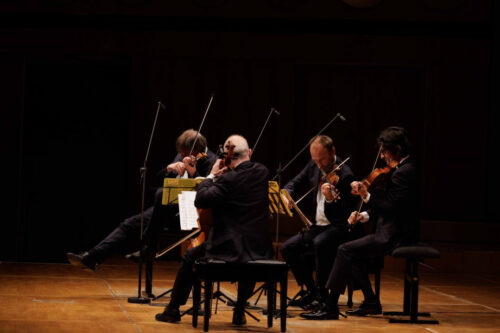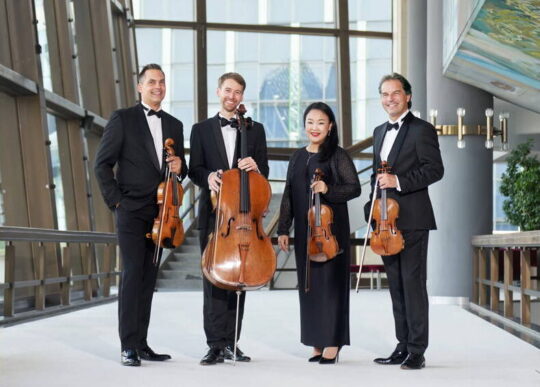 Germany Shostakovich Festival Leipzig [7]: Quatuor Danel (Marc Danel [first violin], Gilles Millet [second violin], Vlad Bogdanas [viola], Yovan Markovitch [cello]), Gewandhaus Quartet (Frank-Michael Erben [first violin], Yun-Jin Cho [second violin], Vincent Aucante [viola], Jürnjakob Timm [cello]). Mendelssohn Hall, Gewandhaus, Leipzig, 18.5.2025. (GT)
Germany Shostakovich Festival Leipzig [7]: Quatuor Danel (Marc Danel [first violin], Gilles Millet [second violin], Vlad Bogdanas [viola], Yovan Markovitch [cello]), Gewandhaus Quartet (Frank-Michael Erben [first violin], Yun-Jin Cho [second violin], Vincent Aucante [viola], Jürnjakob Timm [cello]). Mendelssohn Hall, Gewandhaus, Leipzig, 18.5.2025. (GT)

Shostakovich – Quartet No.13 in B-flat minor, Op.138, Two Pieces from String Octet, Op.11; Quartet No.5 in B-flat major, Op.92
This second concert in the French/Belgian ensemble’s traversal of the complete cycle of string quartets featured the Gewandhaus Orchestra’s string quartet in Shostakovich’s Two Pieces for Octet. The Gewandhaus Quartet was formed in 1808 and collaborated with outstanding musicians of the nineteenth and twentieth centuries, including Clara Schumann, Mendelssohn, Brahms, Reger and Nikisch. The Quatuor Danel gave their first concerts in 1991, and I was privileged to hear the ensemble in Leningrad at the Shostakovich Chamber Music Competition later that year. Their performances were impressive, and it was evident of their affinity for Russian music. Since which, they have recorded the Shostakovich quartet cycle twice, including their latest which was recorded here in Leipzig three years ago.
The opening of the Thirteenth Quartet (Adagio – Doppio Movimento- Tempo primo) began with an intense passage from Marc Danel in which he seemed to invoke all the tragic agonies of the composer’s life. Like much of his career, Shostakovich had to endure terrible issues of personal loss, revolution and war and it seemed as if all his grieving is in the protracted Adagio in which each player evinced a sense of mourning. As in his Twelfth Quartet, the composer uses twelve-note material. The idiom created was overwhelmingly dark and almost painful in expression. Violent imagery emerged in a quickly moving sequence – played with excessive ferocity – and a lamenting triplet invoked a sudden transformation, prompting the players to hit their instruments with their bows. The whole work ended on a prolonged high B-flat that developed in growing intensity – hinting at something terrible – Gilles Millet introduced contrasting undertones, and the citation of twelve-note intonation on the viola of Vlad Bogdanas was expressed with considerable artistry and skill. At last, the work closed without any resolution.
The Gewandhaus Quartet joined their colleagues in Shostakovich’s rarely heard Two Pieces for Octet. The piece dates from the early period between his First Piano Trio, the First Piano Sonata, and the First Symphony when he had yet to assert his personality. The first movement (Prelude. Adagio) is a pastiche of the baroque and employs pizzicato and spiccato and experiments with con sordino effects. The idiom is light-hearted with little seriousness or drama. In the Scherzo. Allegro molto for the first time, the young composer uses his name in the D-S-C-H citation, and here it is heard sarcastically – almost like a joke. The piece was premiered in 1927. In this collaboration between the two ensembles, the standard of performance was remarkable, and one wants to hear more from the distinguished Gewandhaus Quartet.
The Fifth Quartet not only showcases the composer’s profound artistry but also offers listeners a compelling journey through emotional depths and elaborate musical discourse. The piece was composed in the early 1950s when the composer remained affected by the 1948 condemnation of ‘formalist’ composers. The work features thematic continuity across its three movements. The opening theme, presented by the viola, references the composer’s DSCH motif and is repeated twelve times. This anticipates the future Tenth Symphony. The first movement marked Allegro non troppo is structured in large-scale sonata form, and each musician excelled in evincing the quirky ideas in this mature piece, most notably, the beautifully late-romantic idea on the first violin.
The profoundly emotional second movement (Andante) was as if an affectionate memory of something dear and treasured by Shostakovich. In the third movement (Moderato) the mood became enlightened by reprising ideas from the opening movement in a sequence of intricate counterpoint, possibly influenced by Shostakovich’s Twenty-Four Preludes and Fugues. There emerged ideas that would appear in the Tenth Symphony, and the magnificently performed culminating passages ended with uncertainty and ambiguity. This was an outstanding concert, made evident by many in the audience giving the musicians a standing ovation at the close.
Gregor Tassie
Featured Image: Gewandhaus Quartet
